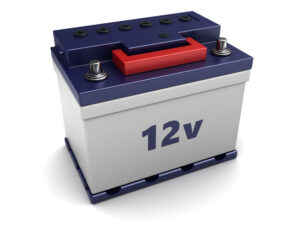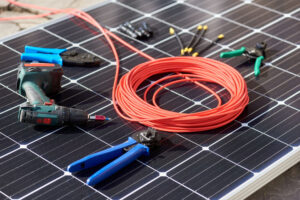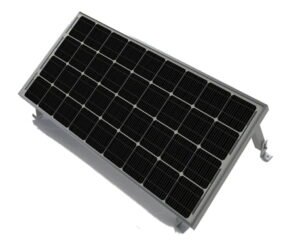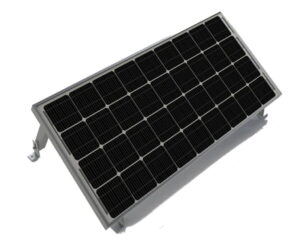Safety First, Second, and Third
 A lot of people see themselves as DIY experts on everything they own. I admit that I’ve held that belief from time-to-time too. I’ve started on numerous projects believing that I knew or at least I would learn what I needed to know as I got the job done. That’s fine putting up crown molding in the spare bedroom, but a DIY RV solar installation should not be one of those things you learn as you go.
A lot of people see themselves as DIY experts on everything they own. I admit that I’ve held that belief from time-to-time too. I’ve started on numerous projects believing that I knew or at least I would learn what I needed to know as I got the job done. That’s fine putting up crown molding in the spare bedroom, but a DIY RV solar installation should not be one of those things you learn as you go.
 You should have a thorough knowledge of electricity and how to be safe with it before you begin designing, building, or installing anything. In the case of electricity, what you don’t know can severely injure or kill you or cause a catastrophic fire. One hazard many RVers forget about is how to prevent a fall from the roof of their RV. This article, Three Dangerous Attitudes that Lead to Fatal Falls, was eye-opening. According to the Bureau of Labor Statistics, 25% of fatal workplace falls in 2013 were from less than 10 feet, and 43% were from less than 15 feet((Bureau of Labor Statistics: https://www.bls.gov/opub/mlr/2016/article/pdf/injuries-from-falls-to-lower-levels-2013.pdf)). The roof of our RV is 12 foot 6 inches.
You should have a thorough knowledge of electricity and how to be safe with it before you begin designing, building, or installing anything. In the case of electricity, what you don’t know can severely injure or kill you or cause a catastrophic fire. One hazard many RVers forget about is how to prevent a fall from the roof of their RV. This article, Three Dangerous Attitudes that Lead to Fatal Falls, was eye-opening. According to the Bureau of Labor Statistics, 25% of fatal workplace falls in 2013 were from less than 10 feet, and 43% were from less than 15 feet((Bureau of Labor Statistics: https://www.bls.gov/opub/mlr/2016/article/pdf/injuries-from-falls-to-lower-levels-2013.pdf)). The roof of our RV is 12 foot 6 inches.
Danger! Danger! Danger!
When I was a young boy, electricity killed a neighbor while working for the power company on powerlines in front of his very own home. Several years later, my brother, who had an electrician’s license, was injured in an electrical fire while working in an electrical box at his workplace. He suffered 3rd-degree electrical burns on his left hand, and fortunately, he made a full recovery.
As I stated in my previous blog post, RV Solar 20 Questions,
As you get started in this process, the first thing you need to consider is how knowledgeable you are about electricity and electrical design? If you’re don’t have a high level of knowledge about them, then your answer to the first question above, “Do you want to hire a professional for the design and installation of your solar system or do-it-yourself?” should be fairly straightforward: I’m going to hire a professional.
If you want to learn more, you can always ask the professional if you can shadow them or assist in any way.
Isn’t 12 Volt Safe for DIY RV Solar Installation?
 A few people will read this and say, “Well, I’m only going to use 12-volt batteries and 12-volt solar panels, so I don’t have to be concerned about safety.” While a 12-volt system may be safer, a 12-volt battery can start a fire if it is shorted, and many 12-volt batteries can burn you if the electrolyte leaks.
A few people will read this and say, “Well, I’m only going to use 12-volt batteries and 12-volt solar panels, so I don’t have to be concerned about safety.” While a 12-volt system may be safer, a 12-volt battery can start a fire if it is shorted, and many 12-volt batteries can burn you if the electrolyte leaks.
- It is true, technically speaking, that a 12-volt system is safer than a 24-volt system, which in turn, is safer than a 48-volt system. As voltage increases, so does the potential of any accident being lethal. But consider this first:
Did you know that a solar panel starts generating electricity as soon as you take it out of the box? There is no off switch. In fact, the HQST 100 Watt 12-Volt Monocrystalline Solar Panel I mentioned in DIY RV Solar Panel Tilting and How To Mount Them can generate 21.3 volts and 5.83 amps the moment light hits it. Yes, 21.3 volts, not 12 volts, but more on that later.
FYI, some lithium-ion batteries can violently explode in a huge ball of gas and fire if they are overcharged or shorted. That’s not to say all lithium battery technologies will explode, but certain ones can, and I don’t want anyone to get hurt. I say these things because I want you to be sure that you understand what you are doing before attempting to DIY your RV solar design and installation. It can be done safely. I’ve done it, and I have lots of friends who have done it, but we have studied electricity and solar power for years.
Final Thoughts on DIY RV Solar Installation
I’m not trying to convince you that you can’t DIY an RV solar installation. I don’t know your level of expertise. Deciding to design and install your own RV solar system is wholly your responsibility. Regardless of whether you decide to DIY your RV solar installation or hire a professional, I hope to provide you with some useful information you might not have thought of on your own. In closing, here is an excellent article by The Heartford Insurance regarding Solar Energy Risks. This and other articles on RV Solar can be found on our Trusted Resources page.
Remember, it’s Safety First, Second, and Third!
P.S. I’m not a professional solar installer or reseller, so I have nothing to lose or gain if you install your own RV solar system.

 That’s fantastic! RV solar solutions come in all shapes and sizes. You can buy a solar system as a kit or buy individual components on an a la carte basis. You can even pay someone to design, build, and install the entire system for you, but more information on that later.
That’s fantastic! RV solar solutions come in all shapes and sizes. You can buy a solar system as a kit or buy individual components on an a la carte basis. You can even pay someone to design, build, and install the entire system for you, but more information on that later. Where Do You Begin?
Where Do You Begin?

 I received a question on
I received a question on  2020 is finally over!
2020 is finally over!